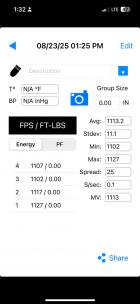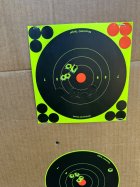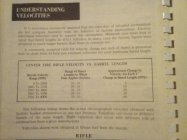Only if your lucky.
Basically you interpreted the chart to fit your narrative.
The bullet is gaining velocity with barrel length, but the rate of gain is dropping. So a bullet with a muzzle velocity of 2000 fps at 20” will gain 5fps for the next 6”. But a 16” barrel will gain 15 fps from 16-20”(made up number it will actually be higher most often).
If you want to extrapolate data from that chart, for every 500 fps change in velocity, the rate of velocity gain per inch of barrel doubles, or halves depending on if you read the chart top to bottom, bottom to top. So a bullet with a muzzle velocity of 1500 fps in a 20” barrel would only gain 2.5 fps per inch, and 1000 fps would gain 1.5 fps per inch. This actually is pretty close to my live fire experience. They start losing velocity 22-26” when the load was developed for an 8” barrel.
So the shorter the barrel, the more velocity loss per inch and it’s not linear, more exponential. The drop from 24”-20” will be 20 fps. The drop from 20”-16” will be closer to 40-60 fps, possibly a total of 60-80 fps. More or less double what you predicted.
The problem is paper predictions and actual results with subs in a rule of thumb chart like above, is basically nonsense. The results of an 80 grain 22 caliber bullet vs a 350 grain 38 caliber bullet will be different. As will be a lubed lead vs a copper solid.
It’s very frustrating to talk subs with people who have not loaded them over many cartridges and barrel length. It’s just not like supers.
OK dellet, GAME ON!!! I ACCEPT YOUR CHALLENGE!!!!
I was using the KISS PRINCIPLE for a really rough estimate!!!
I'm looking at the 308 (26" test barrel) loads for the 180 grain cast bullet with gas check from the Lyman manual where they are using pistol and shotgun powders!!! Velocities run, with the minimum powder charges, from 1200 to 1457!!! I trust the Lyman rough estimate barrel length chart since they are the old timers dealing with squib and low velocity lead cast bullets w/wo gas checks!!!
So, the drop in muzzle velocity from 24" to 20" is 1057 - (4" * 5) = 1037f/s!!!
There is a reason for Lyman stopping at 20"!!!
I think is for the lead and squib loads using fast burn powder burning up at that average or mean distance!!
Now lets move on and find how much more drop in velocity with the last 4"!!!
Let's use Engineering Physics!!!
I'm going to make an assumption that the base of the bullet is at the shoulder/neck junction which is 2.015" from the base!!!
So, the base of the bullet will roughly be 2" (simplified for calculations) on the breach end of the barrel!!
The true length will not be that critical since we are rough estimating!!!
For the 20" barrel, the bullet will travel 18"!!!
For the 16" barrel the bullet will travel 14"!!!
The initial velocity (Vi) will be 0f/s.
The final velocity (Vf) for the 20" barrel is 1037f/s rough estimated.
The acceleration will include the deceleration due to friction since the MV=1037f/s.
Time to find the acceleration (a)!!!!!!!!!
For the 20" barrel x=18" at this time for finding acceleration!!!!
a = (Vf^2 - Vi^2) / (2x) = Vf^2/2x = 29,871f/s^2
Now that we know the acceleration, the new Vf will be for the 16" Muzzle velocity!!!
x will now be equal to 14"!!!!!!
Rearranging the formula will simplify the equalities!!
Vf = (2 * a * x)^(1/2) = 915f/s Muzzle velocity for the 16" barrel
SO, THE THEORETICAL DROP IN VELOCITY (20" to 16") IS 1037 - 915 = 122f/s!!!
Or, 122/4 = 30.5f/s for each inch of barrel change below 20"!!
The total drop in velocity is 142f/s for the full 8" change in barrel lengths!!!!!
Now, I know you are going to tear this apart, dellet!!!!
I'm trying to show the other members the Physics aspect of the problem that the OP gave us!!
Sometimes, Real life result can be much different than the theoretically calculated prediction!!!
I have never messed with squib loads or subsonic rounds other the subsonic 22 rims!!!!
BILL!!!!!!!!!!















